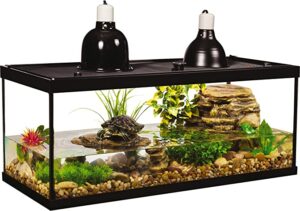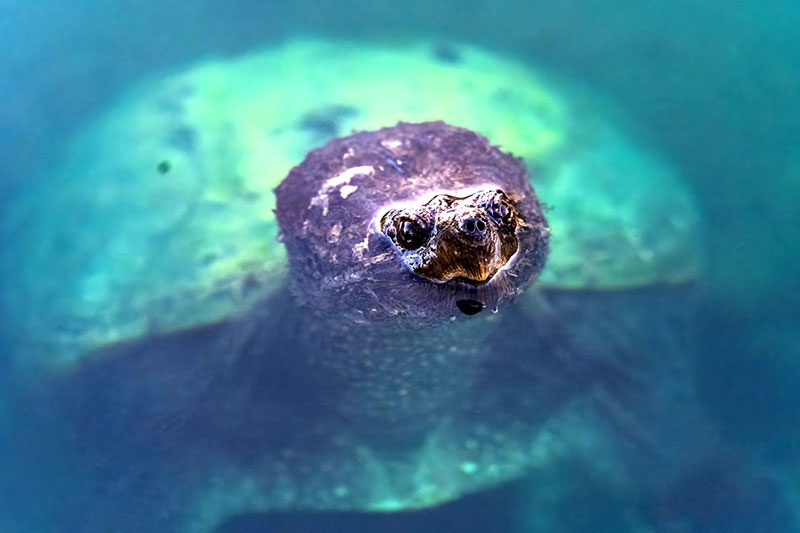Anyone who is a turtle enthusiast knows that snapping turtles are some of the coolest turtles around! They’re big, powerful and have a personality that can’t be beat. If you’re lucky enough to have a snapping turtle as a pet, you’ll want to ensure that you set up their tank correctly so that they thrive and live a long, healthy life.
What Size Tank Does a Snapping Turtle Need?

There are a few things to consider when determining the pet snapping turtle tank size. First, consider the adult size of the turtle species. Some turtles grow to be quite large, so you’ll need a correspondingly large tank.
Second, think about the turtle’s activity level. An active turtle will need more space to move around than a sedentary one. You should also consider the number of turtles you plan to keep in the tank—more turtles means you’ll need a larger tank. Finally, remember that turtles are messy creatures and need plenty of space for filtration and water changes.
You can generally keep hatchlings in a 10-gallon tank and adults require at least a 2-by-4-foot enclosure. However, given the impressive growth rate of the snapping turtle, larger is always a good rule of thumb. It’s even better if you can get about six inches of aquarium floor space for every inch of turtle.
How To Set Up a Snapping Turtle Tank
Now that you have the right tank for your snapping turtle, the next step is to think about setting up the snapping turtle tank so that you can give it the right environment to thrive.
1. Choose the right location for your turtle tank
Your tank should be in a quiet area of your home where your turtle won’t be disturbed. It’s also important to find a spot that receives natural sunlight. Turtles need UV light to stay healthy, so an artificial light source isn’t sufficient.
2. Set up your turtle tank according to the manufacturer’s instructions
This will typically involve adding a layer of gravel or sand to the bottom of the tank and then filling it with water. Be sure to use dechlorinated water, as chlorinated water can be harmful to turtles.
3. Add some hiding places for your turtle
Turtles like to have somewhere to hide from the light and noise of the world outside their tank. You can add rocks, logs or even plastic plants to provide them with shelter. Just be sure that any objects you add are safe for turtles and won’t fall apart in the water.
4. Install the filtration system
Another important consideration when setting up your turtle tank is filtration. Given their size and diet, turtles generate a lot of waste, which can quickly taint the water in their tank. You’ll need to install a quality filtration system to keep the water clean and safe for your pet. Canister filters are often recommended for turtle tanks since they’re powerful enough to handle the extra workload.
5. Install a basking and UVB light over your turtle tank
These lights will help your turtle stay warm and produce vitamin D3, which is essential for its health. Be sure to follow the manufacturer’s instructions when installing these lights, as improper installation can be dangerous. The water in your turtle tank should be kept between 75 to 85 degrees Fahrenheit using an aquarium heater.
How To Clean a Snapping Turtle Tank
Cleaning a snapping turtle tank is not as difficult as it may seem. The most important thing to remember is to do it regularly, at least once a week, following these steps.
- Remove your turtle from the tank and place them in a temporary enclosure. This can be a plastic tub or a clean water sink.
- Empty the entire contents of the tank, including the water. Be sure to dispose of the old water properly; do not simply pour it down the drain.
- Once the tank is empty, wash all of the surfaces with warm, soapy water and rinse carefully and completely before proceeding to the next step.
- Sanitize the tank using a diluted bleach solution (one part bleach to ten parts water). Again, be sure to rinse away any traces of bleach before continuing.
- Once the tank is clean and sanitized, refill the tank with fresh water and put your turtle back inside.
How Much Water To Add to a Snapping Turtle Tank
The amount of water you’ll need in the tank for your snapping turtle depends on its size. A general rule of thumb is to have at least 10 gallons of water for each inch of the turtle shell. For a four-inch turtle, you’ll need at least 40 gallons of water. The water should also be deep enough that the turtle can completely submerge itself.
How To Maintain a Snapping Turtle Tank
Here are a few additional ideas to help keep your snapping turtle habitat tank clean in between its regular cleaning.
- Remove waste and uneaten foods daily to ensure the tank stays clean longer.
- Use a good filter—a necessity for any turtle tank, but especially important for a snapping turtle tank. That’s because snapping turtles are messy eaters and their water can quickly become polluted. A quality filter such as Aqueon Quietflow Internal Power Filter will help to keep the water clean and clear.
- Change the water regularly. Even with a filter, you’ll need to change the water in your snapping turtle tank regularly. A good rule of thumb is to change 20 to 30% of the water weekly.
- Don’t overcrowd your snapping turtle tank. These turtles produce a large amount of waste and too many turtles in one space can quickly lead to poor water quality. So, be sure to give your turtle enough room to move around and stay healthy.


